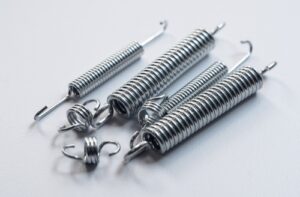When it comes to mechanical spring design your choice of spring component is essential. Whether it’s microscopic medical stents or rugged industrial equipment or something else entirely the right spring will ensure optimal performance in your application such that it can withstand sufficient stress, provide optimum force, or maintain durability over time.
Begin your mechanical spring design process by outlining the design considerations dictated by your application in order to select a spring manufacturer with the right capabilities.
UNDERSTANDING APPLICATION CONSTRAINTS IN MECHANICAL SPRING DESIGN
To a large extent, spring selection is application dependent. Every application will give rise to its own demands, prompting specific materials or spring types. Factors such as environmental conditions, size constraints and load requirements will all influence your choice, ultimately helping to narrow your search.
Mechanical Spring Design and Medical Devices
Unsurprisingly, the humble spring can be found in a variety of medical equipment such as ventilators and adjustable beds. More recently, however, springs have also been specified in today’s cutting-edge medical device designs destined for use inside the human body. Here, compact size, precision, and reliability are imperative in order to ensure these microscopic medical coils facilitate accurate control.
Look for a spring manufacturer who is able to work to ISO 13485 standards and ensure products adhere to relevant sterilisation protocols to protect patient safety. Whether you are looking for nitinol coils or medical compression springs, components used in hospital applications will face stringent design constraints to meet the needs of critical, life-saving equipment.
Aerospace Spring Design
Springs used in aerospace or aviation designs will face several design constraints. They must adhere to strict weight limits, withstand extreme temperature variations, and meet aerospace standards for durability.
Depending on the atmospheric conditions and pressure demands of your application, you will need to choose an appropriate spring material as components can be manufactured from a variety of metals. In all cases, whether you’re working on an aircraft landing system or satellite antenna, you will need to focus on precision, reliability and resistance to fatigue, all of which are critical to ensuring repeatable performance in demanding aerospace environments.

SELECTING SPRING TYPE IN MECHANICAL SPRING DESIGN
With the basic constraints and requirements of your application established, you’re ready to select which type of spring best meets your needs.
The construction of your spring will significantly affect its basic characteristics. Factors such as wire diameter, coil diameter, number of coils and material choice will all impact the stiffness, load capacity, and durability of your spring component. With common spring types such as compression, extension, and torsion all offering different behaviours, it’s important to choose a construction method that will offer the required tension for many years to come.
Compression Springs
Compression springs store potential energy when compressed and release it when the force is removed, returning to their original state. They are often designed to be used in a bore or over a rod, so you will need to pay close attention to both the inner and outer diameters, as well as the solid (or compressed) height, which will be influenced by the coil diameter and the total amount of coils. Depending on your compression spring’s dimensions and material, it will have a maximum load, beyond which it could experience fatigue issues.
Extension Springs
Designed to work in the opposite way to compression springs, extension springs work by resisting force. They store energy when stretched and release it when the force is removed, returning to their original position. In practice, extension springs are usually wound with initial tension, which holds the coils together at rest. This means, to extend the spring, you must apply a force greater than the initial tension. You will therefore need to think carefully about space constraints and fatigue resistance, as well as the configuration of spring ends. Various formed ends can be used to attach the load including extended loops, hooks, or eyes.
Torsion Springs
Torsion springs resist torque when twisted, storing energy in the twist and releasing it when the torque is removed. To select the right component, you will need to calculate the required torque for your application as well as the desired rotation or angular displacement. During operation torsion springs will reduce in coil diameter while increasing in body length as they are deflected. This means you will need to allow for these changes in order to maintain any clearances with surrounding design elements.
ENLIST AN EXPERT SPRING MANUFACTURER FOR YOUR MECHANICAL SPRING DESIGN
When standard springs simply do not meet your application requirements, you may need to opt for a bespoke spring design.
By discussing your specific mechanical spring design constraints with an expert spring manufacturer, you should be able to tailor a spring to your unique load, space or environmental demands and optimise performance to your application.
In rugged industrial projects, for example, you may require a specific coil finish or coating, while for medical devices you might require micro-fine wire coiling to create a microscopic device suitable for use within the body’s vascular system. In situations such as these, a customised spring component ensures precise compatibility, enhances system efficiency, and quite often results in a more cost-effective solution than modifying off-the-shelf products.
If your engineering project would benefit from precision spring fabrication and a collaborative approach to spring design, contact SCS.
Our custom, high-performance spring and wire solutions have been helping engineers worldwide to produce more innovative, reliable products for more than four decades. Visit our homepage to learn more.


